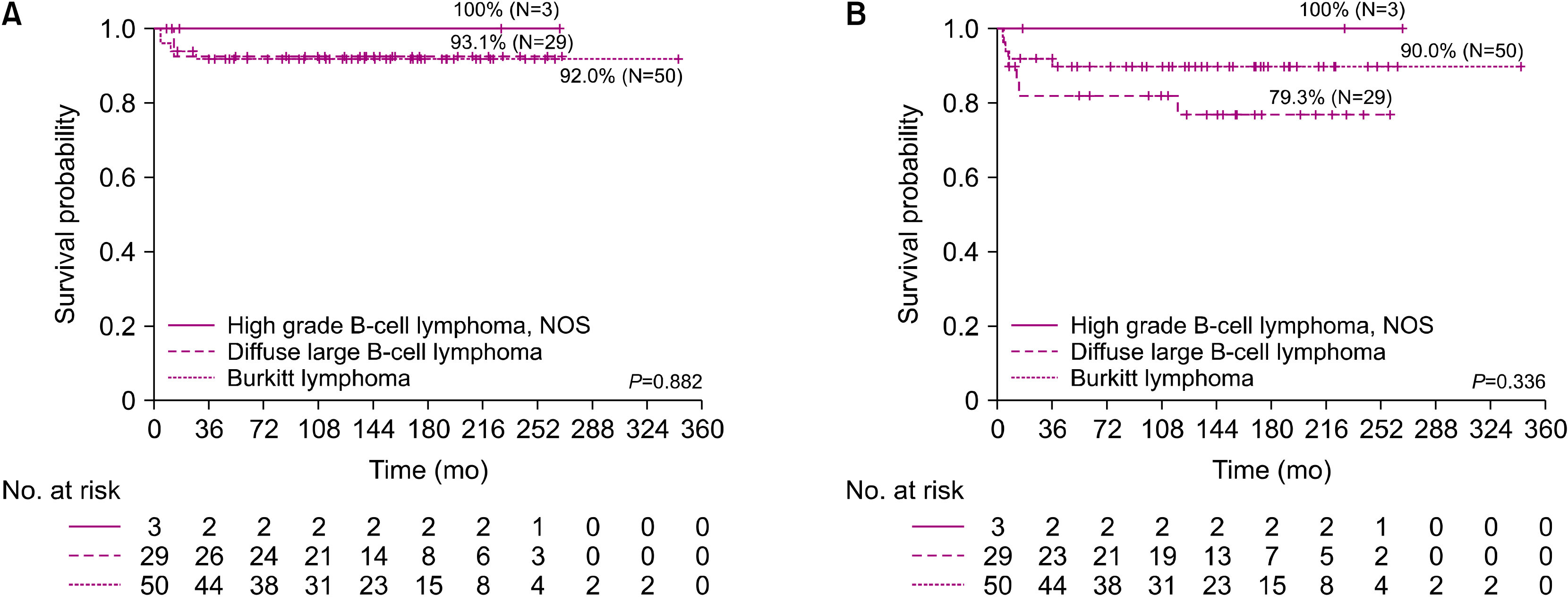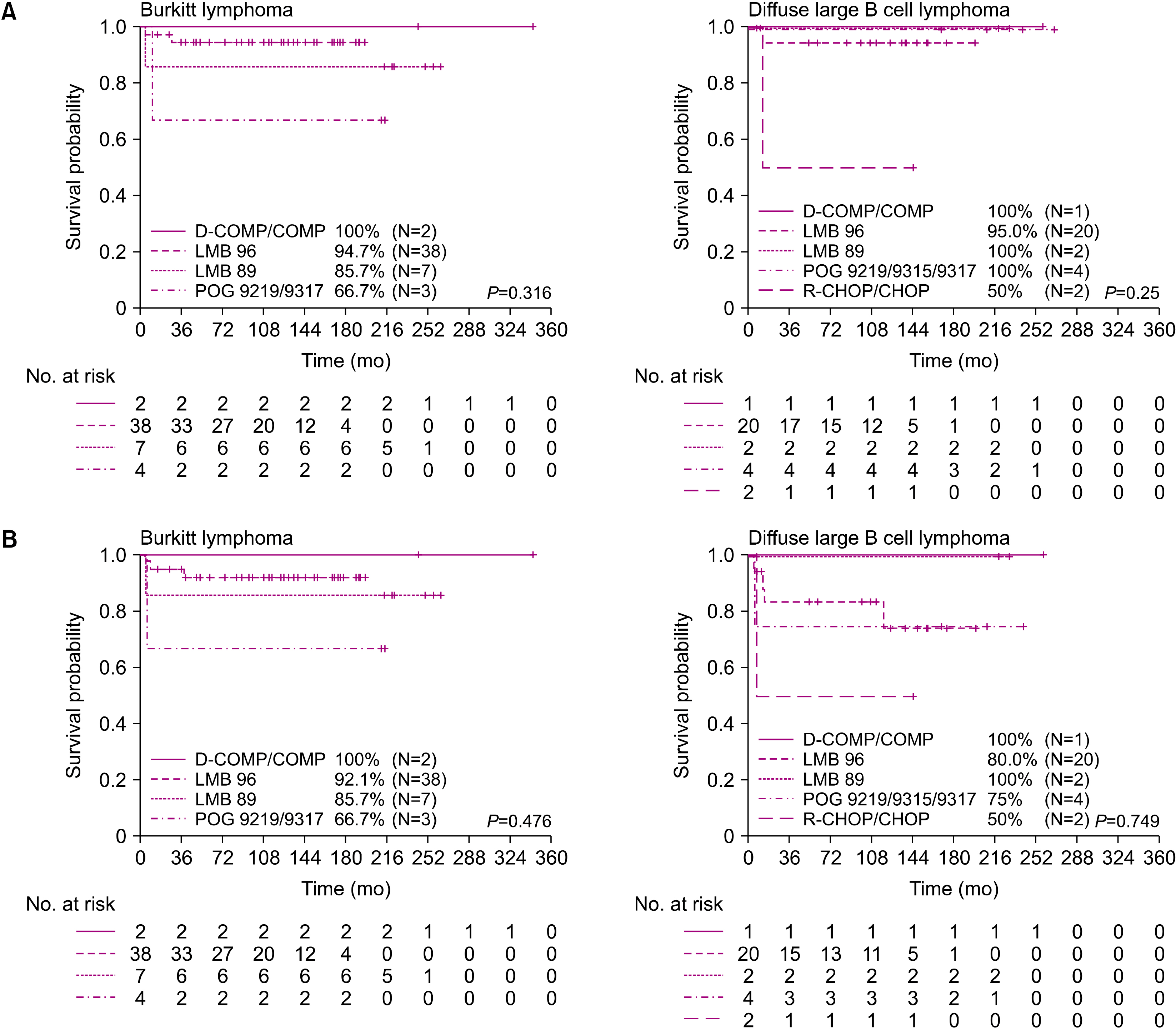Blood Res.
2022 Mar;57(1):41-50. 10.5045/br.2021.2021164.
Clinical characteristics and treatment outcomes of children and adolescents with aggressive mature B-cell lymphoma: a single-center analysis
- Affiliations
-
- 1Department of Pediatrics, University of Ulsan College of Medicine, Asan Medical Center, Seoul, Korea
- 2Division of Pediatric Hematology/Oncology, Department of Pediatrics, University of Ulsan College of Medicine, Asan Medical Center, Seoul, Korea
- KMID: 2527496
- DOI: http://doi.org/10.5045/br.2021.2021164
Abstract
- Background
Aggressive mature B-cell non-Hodgkin lymphoma (B-NHL) is the most common non-Hodgkin lymphoma in children. The outcome of chemotherapy for B-NHL has improved over decades.
Methods
We reviewed 82 children and adolescents with B-NHL diagnosed at Asan Medical Center between 1993 and 2020. The D-COMP/COMP (daunomycin–cyclophosphamide, doxorubicin, vincristine, and prednisolone), Pediatric Oncology Group (POG)-9219/9315/ 9317, R-CHOP/CHOP (rituximab–cyclophosphamide, doxorubicin, vincristine, and prednisolone), and Lymphomes Malins B 89 (LMB89)/LMB96 regimens were administered. In 2018, rituximab was added to the LMB protocol (R-LMB) for advanced-staged Burkitt lymphoma (BL). The patients’ clinical features and treatment outcomes were retrospectively analyzed.
Results
The most common subtype was BL (61%), followed by diffuse large B-cell lymphoma (DLBCL) (35%). The median age was 7.8 (range, 1.3‒16.4) years, and the most frequently used regimen was French‒American‒British (FAB)/LMB96 (58 patients, 70.7%). The 5-year overall survival (OS) and event-free survival (EFS) rates were 92.5% and 85.7%, respectively. The EFS rates of patients with BL and DLBCL were 90.0% and 79.3%, respectively. Among the FAB/LMB risk groups, group C (85.7%) had a significantly lower 5-year OS (P =0.037). Eleven events occurred (6 relapses, 3 deaths, and 2 secondary malignancies) during the median follow-up of 7.1 (range, 3.7‒118.5) months. Two patients treated with R-LMB had good outcomes without complications.
Conclusion
Various treatment regimens have favorable outcomes in pediatric patients with B-NHL. However, further studies are needed to improve survival in high-risk patients. In addition, careful monitoring for acute toxicity or secondary malignancy due to intensive multidrug chemotherapy is required.
Keyword
Figure
Reference
-
1. Davies K, Barth M, Armenian S, et al. 2020; Pediatric aggressive mature B-cell lymphomas, version 2.2020, NCCN Clinical Practice Guidelines in Oncology. J Natl Compr Canc Netw. 18:1105–23. DOI: 10.6004/jnccn.2020.0036. PMID: 32755986.
Article2. Swerdlow SH, Campo E, Pileri SA, et al. 2016; The 2016 revision of the World Health Organization classification of lymphoid neoplasms. Blood. 127:2375–90. DOI: 10.1182/blood-2016-01-643569. PMID: 26980727. PMCID: PMC4874220.
Article3. Gerrard M, Cairo MS, Weston C, et al. 2008; Excellent survival following two courses of COPAD chemotherapy in children and adolescents with resected localized B-cell non-Hodgkin's lymphoma: results of the FAB/LMB 96 international study. Br J Haematol. 141:840–7. DOI: 10.1111/j.1365-2141.2008.07144.x. PMID: 18371107.
Article4. Cairo MS, Beishuizen A. 2019; Childhood, adolescent and young adult non-Hodgkin lymphoma: current perspectives. Br J Haematol. 185:1021–42. DOI: 10.1111/bjh.15764. PMID: 30729513. PMCID: PMC6897376.
Article5. Patte C, Auperin A, Michon J, et al. 2001; The Société Française d'Oncologie Pédiatrique LMB89 protocol: highly effective multiagent chemotherapy tailored to the tumor burden and initial response in 561 unselected children with B-cell lymphomas and L3 leukemia. Blood. 97:3370–9. DOI: 10.1182/blood.V97.11.3370. PMID: 11369626.6. Patte C, Auperin A, Gerrard M, et al. 2007; Results of the randomized international FAB/LMB96 trial for intermediate risk B-cell non-Hodgkin lymphoma in children and adolescents: it is possible to reduce treatment for the early responding patients. Blood. 109:2773–80. DOI: 10.1182/blood-2006-07-036673. PMID: 17132719. PMCID: PMC1852229.
Article7. El-Mallawany NK, Cairo MS. 2015; Advances in the diagnosis and treatment of childhood and adolescent B-cell non-Hodgkin lymphoma. Clin Adv Hematol Oncol. 13:113–23. PMID: 25774481.8. Minard-Colin V, Aupérin A, Pillon M, et al. 2020; Rituximab for high-risk, mature B-cell non-Hodgkin's lymphoma in children. N Engl J Med. 382:2207–19. DOI: 10.1056/NEJMoa1915315. PMID: 32492302. PMCID: PMC7720281.
Article9. Moleti ML, Testi AM, Foà R. 2020; Treatment of relapsed/refractory paediatric aggressive B-cell non-Hodgkin lymphoma. Br J Haematol. 189:826–43. DOI: 10.1111/bjh.16461. PMID: 32141616.
Article10. Simonin M, Auperin A, Bertrand Y, et al. 2020; In childhood mature B-NHL with CNS disease, patients with blasts in cerebrospinal fluid are at higher risk of failure. Blood Adv. 4:3621–5. DOI: 10.1182/bloodadvances.2019001398. PMID: 32766852. PMCID: PMC7422110.
Article11. Murphy SB. 1980; Classification, staging and end results of treatment of childhood non-Hodgkin's lymphomas: dissimilarities from lymphomas in adults. Semin Oncol. 7:332–9.12. Cairo MS, Gerrard M, Sposto R, et al. 2007; Results of a randomized international study of high-risk central nervous system B non-Hodgkin lymphoma and B acute lymphoblastic leukemia in children and adolescents. Blood. 109:2736–43. DOI: 10.1182/blood-2006-07-036665. PMID: 17138821. PMCID: PMC1852225.
Article13. Anderson JR, Jenkin RD, Wilson JF, et al. 1993; Long-term follow-up of patients treated with COMP or LSA2L2 therapy for childhood non-Hodgkin's lymphoma: a report of CCG-551 from the Childrens Cancer Group. J Clin Oncol. 11:1024–32. DOI: 10.1200/JCO.1993.11.6.1024. PMID: 8501488.
Article14. Link MP, Shuster JJ, Donaldson SS, Berard CW, Murphy SB. 1997; Treatment of children and young adults with early-stage non-Hodgkin's lymphoma. N Engl J Med. 337:1259–66. DOI: 10.1056/NEJM199710303371802. PMID: 9345074.
Article15. Hutchison RE, Laver JH, Chang M, et al. 2008; Non-anaplastic peripheral T-cell lymphoma in childhood and adolescence: a Children's Oncology Group study. Pediatr Blood Cancer. 51:29–33. DOI: 10.1002/pbc.21543. PMID: 18300314. PMCID: PMC4447625.
Article16. Laver JH, Kraveka JM, Hutchison RE, et al. 2005; Advanced-stage large-cell lymphoma in children and adolescents: results of a randomized trial incorporating intermediate-dose methotrexate and high-dose cytarabine in the maintenance phase of the APO regimen: a Pediatric Oncology Group phase III trial. J Clin Oncol. 23:541–7. DOI: 10.1200/JCO.2005.11.075. PMID: 15659500.
Article17. Pui CH, Campana D, Pei D, et al. 2009; Treating childhood acute lymphoblastic leukemia without cranial irradiation. N Engl J Med. 360:2730–41. DOI: 10.1056/NEJMoa0900386. PMID: 19553647. PMCID: PMC2754320.
Article18. Burnett AK, Hills RK, Milligan DW, et al. 2010; Attempts to optimize induction and consolidation treatment in acute myeloid leukemia: results of the MRC AML12 trial. J Clin Oncol. 28:586–95. DOI: 10.1200/JCO.2009.22.9088. PMID: 20038732.
Article19. Goldman S, Smith L, Galardy P, et al. 2014; Rituximab with chemotherapy in children and adolescents with central nervous system and/or bone marrow-positive Burkitt lymphoma/leukaemia: a Children's Oncology Group report. Br J Haematol. 167:394–401. DOI: 10.1111/bjh.13040. PMID: 25066629. PMCID: PMC4198418.
Article20. Song JS, Youn HS, Im HJ, Ghim T, Moon HN, Seo JJ. 2006; Treatment outcome and prognostic factors for children with advanced non-Hodgkin's lymphoma at a single institution. Korean J Hematol. 41:157–66. DOI: 10.5045/kjh.2006.41.3.157.
Article21. Harker-Murray PD, Pommert L, Barth MJ. 2020; Novel therapies potentially available for pediatric B-cell non-Hodgkin lymphoma. J Natl Compr Canc Netw. 18:1125–34. DOI: 10.6004/jnccn.2020.7608. PMID: 32755987.
Article22. Lee HG, Choi Y, Kim SY, et al. 2014; R-CHOP chemoimmunotherapy followed by autologous transplantation for the treatment of diffuse large B-cell lymphoma. Blood Res. 49:107–14. DOI: 10.5045/br.2014.49.2.107. PMID: 25025012. PMCID: PMC4090331.
Article23. Goldman S, Smith L, Anderson JR, et al. 2013; Rituximab and FAB/LMB 96 chemotherapy in children with stage III/IV B-cell non-Hodgkin lymphoma: a Children's Oncology Group report. Leukemia. 27:1174–7. DOI: 10.1038/leu.2012.255. PMID: 22940833. PMCID: PMC4539148.
Article24. Li S, Seegmiller AC, Lin P, et al. 2015; B-cell lymphomas with concurrent MYC and BCL2 abnormalities other than translocations behave similarly to MYC/BCL2 double-hit lymphomas. Mod Pathol. 28:208–17. DOI: 10.1038/modpathol.2014.95. PMID: 25103070.
Article25. Uemura S, Hasegawa D, Yokoi T, et al. 2017; Refractory double-hit lymphoma/leukemia in childhood mimicking B-precursor acute lymphoblastic leukemia at initial presentation. Rinsho Ketsueki. 58:143–9. DOI: 10.11406/rinketsu.58.143. PMID: 28321092.26. Thirunavukkarasu B, Samanta J, Bhatia P, Bal A. 2021; De novo double-hit B-cell precursor leukemia/lymphoma - an unusual presentation as peritoneal lymphomatosis. Autops Case Rep. 11:e2021278. DOI: 10.4322/acr.2021.278. PMID: 34307232. PMCID: PMC8214895.
Article27. Frazer JK, Li KJ, Galardy PJ, et al. 2019; Excellent outcomes in children and adolescents with CNS+Burkitt lymphoma or other mature B-NHL using only intrathecal and systemic chemoimmunotherapy: results from FAB/LMB96 and COG ANHL01P1. Br J Haematol. 185:374–7. DOI: 10.1111/bjh.15520. PMID: 30117142. PMCID: PMC6588172.
Article28. Wössmann W, Schrappe M, Meyer U, Zimmermann M, Reiter A. 2003; Incidence of tumor lysis syndrome in children with advanced stage Burkitt's lymphoma/leukemia before and after introduction of prophylactic use of urate oxidase. Ann Hematol. 82:160–5. DOI: 10.1007/s00277-003-0608-2. PMID: 12634948.
Article29. Turcotte LM, Liu Q, Yasui Y, et al. 2019; Chemotherapy and risk of subsequent malignant neoplasms in the Childhood Cancer Survivor Study cohort. J Clin Oncol. 37:3310–9. DOI: 10.1200/JCO.19.00129. PMID: 31622130. PMCID: PMC7001784.
Article30. Ehrhardt MJ, Chen Y, Sandlund JT, et al. 2019; Late health outcomes after contemporary Lymphome Malin de Burkitt therapy for mature B-cell non-Hodgkin lymphoma: a report from the Childhood Cancer Survivor Study. J Clin Oncol. 37:2556–70. DOI: 10.1200/JCO.19.00525. PMID: 31283408. PMCID: PMC7001792.
Article
- Full Text Links
- Actions
-
Cited
- CITED
-
- Close
- Share
- Similar articles
-
- Clinical Characteristics and Treatment Outcomes of Non-anaplastic Peripheral T-Cell Lymphoma in Children and Adolescents: A Single-center Experience
- Diagnostic Approach for Double-Hit and Triple-Hit Lymphoma Based on Immunophenotypic and Cytogenetic Characteristics of Bone Marrow Specimens
- A Case of Aggressive NK/T-cell Lymphoma/Leukemia with Cutaneous Involvement in Adolescence
- Clinical Characteristics of Aggressive Behavior Problems in Children with Autism Spectrum Disorder: Preliminary Study
- A Case of Peripheral T - cell Lymphoma







